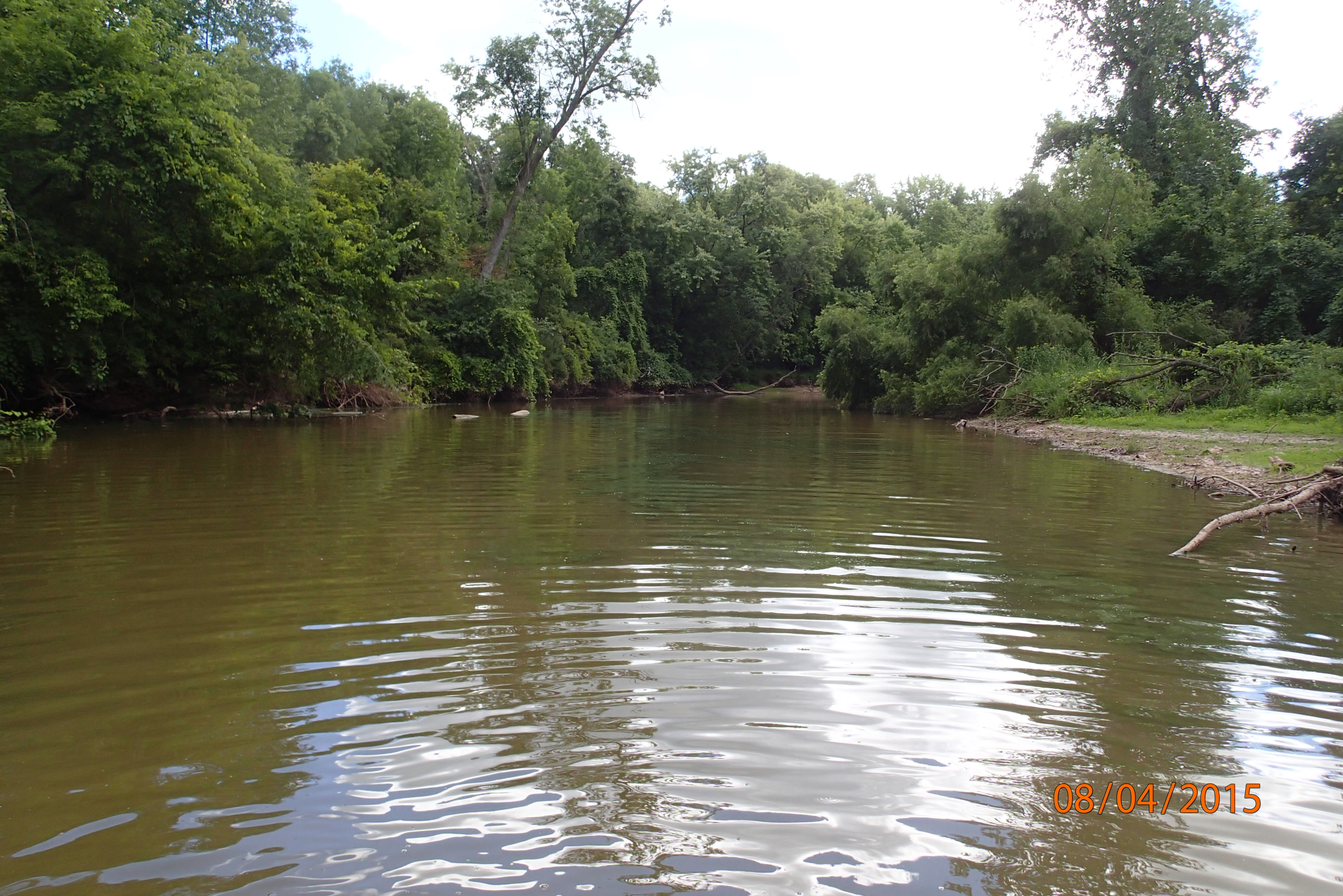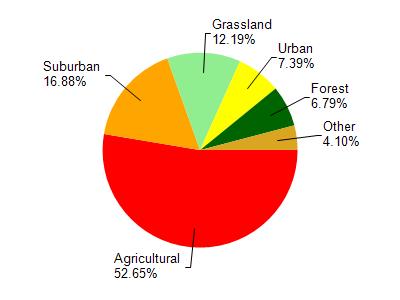
2.55 Miles
13.87 - 16.42
Macroinvertebrate
2025
Poor
Elevated Water Temperature, Degraded Habitat
Sediment/Total Suspended Solids
Brown, Calumet
No
No
Yes
Fish and Aquatic Life
Overview
Plum Creek, is a 19-mile stream with poor water quality. Aquatic life habitat of Plum Creek is generally poor. Clay is the predominant substrate type with little gravel, rubble and sand present. Many of the pools that are necessary to support fish and other aquatic life have been filled in from bank erosion and upland sediment runoff. The streambanks are eroding because of the lack of stable bank protection and from frequent flooding. Stream flow appears to be a major limiting factor for aquatic life during the summer months. Macroinvertebrate sample results indicate poor to good water quality with very significant to some organic pollution present. Macroinvertebrate abundance and diversity appears to be limited by the lack of suitable habitat. The water is generally very turbid, which limits light penetration for desirable rooted aquatic plants. Filamentous algae, however, appears to be common on the rocks and along the banks. Suspended solids, total and dissolved phosphorus and bacteria levels were excessively high during runoff event sampling. The Fox River receives a high pollutant loading from Plum Creek. Plumes of sediment are evident where Plum Creek discharges to the Fox River in the spring of the year.
Bougie, Cheryl A. 1999. Lower Fox River Basin Water Quality Management Plan. Public Review Draft. Wisconsin Department of Natural Resources, Madison, WI.
Date 1999
Author Cheryl Bougie
Impaired Waters
Plum Creek, from Forest Junction WWO to headwaters (miles 16.42 to 19.50), was listed as impaired in 1998 due to elevated temperature and degraded habitat impairments caused by sediment/TSS. This water is part of the Lower Fox River TP & TSS TMDL that was approved by the EPA in 2012.
Date 2022
Author Ashley Beranek
Impaired Waters
Plum Creek, from its mouth to unnamed tributary (WBIC 125600) (miles 0 to 13.86), was listed as impaired in 1998 due to elevated temperature and degraded habitat impairments caused by sediment/TSS. Total phosphorus was added as a pollutant to the degraded habitat impairment listing in 2008. This water is part of the Lower Fox River TP & TSS TMDL that was approved by the EPA in 2012. Evaluations every two-year cycle from 2012 to 2022 confirmed the phosphorus impairment.
Date 2022
Author Ashley Beranek
Impaired Waters
Plum Creek, from unnamed tributary (WBIC 125600) to Forest Junction WWO (miles 13.87 to 16.42), was put on the impaired waters list in 1998 for sediment/total suspended solids, elevation water temperature, and degraded habitat. This water is part of the Lower Fox River TP & TSS TMDL that was approved by the EPA in 2012.
Date 2022
Author Ashley Beranek
Condition
Wisconsin has over 84,000 miles of streams, 15,000 lakes and milllions of acres of wetlands. Assessing the condition of this vast amount of water is challenging. The state's water monitoring program uses a media-based, cross-program approach to analyze water condition. An updated monitoring strategy (2015-2020) is now available. Compliance with Clean Water Act fishable, swimmable standards are located in the Executive Summary of Water Condition in 2018. See also the 'monitoring and projects' tab.
Reports
Recommendations
Navigability Determination
S33 T21N R19E; ; Determination started in Outagamie Cty
Navigability Determination
S33 T21N R19E; ; Determination started in Outagamie Cty
Nine Key Element Plan
Plum and Kankapot Creek Watersheds PWS Plan - Nine Key Element Plan - The Plum and Kankapot Watershed is a subwatershed of the Lower Fox River Watershed and is located in east central Wisconsin in Brown, Outagamie, and Calumet Counties. The Plum and Kankapot Creeks empty into the Lower Fox River draining approximately 38,712 acres. Excessive sediment loads and increased algal blooms in the Lower Fox River and Bay of Green Bay prompted the need for action to be taken in the Lower Fox River Basin.
Management Goals
Wisconsin's Water Quality Standards provide qualitative and quantitative goals for waters that are protective of Fishable, Swimmable conditions [Learn more]. Waters that do not meet water quality standards are considered impaired and restoration actions are planned and carried out until the water is once again fishable and swimmable
Management goals can include creation or implementation of a Total Maximum Daily Load analysis, a Nine Key Element Plan, or other restoration work, education and outreach and more. If specific recommendations exist for this water, they will be displayed below online.
Monitoring
Monitoring the condition of a river, stream, or lake includes gathering physical, chemical, biological, and habitat data. Comprehensive studies often gather all these parameters in great detail, while lighter assessment events will involve sampling physical, chemical and biological data such as macroinvertebrates. Aquatic macroinvertebrates and fish communities integrate watershed or catchment condition, providing great insight into overall ecosystem health. Chemical and habitat parameters tell researchers more about human induced problems including contaminated runoff, point source dischargers, or habitat issues that foster or limit the potential of aquatic communities to thrive in a given area. Wisconsin's Water Monitoring Strategy was recenty updated.
Grants and Management Projects
Monitoring Projects
| WBIC | Official Waterbody Name | Station ID | Station Name | Earliest Fieldwork Date | Latest Fieldwork Date | View Station | View Data |
|---|
| 5022394 | Unnamed | 10050946 | Plum Creek ESE | 4/18/2017 | 5/31/2017 | Map | Data |
| 125100 | Plum Creek | 10050946 | Plum Creek ESE | 4/18/2017 | 5/31/2017 | Map | Data |
| 125500 | Unnamed | 10050946 | Plum Creek ESE | 4/18/2017 | 5/31/2017 | Map | Data |
| 5553610 | Unnamed | 10050946 | Plum Creek ESE | 4/18/2017 | 5/31/2017 | Map | Data |
| 5021907 | Unnamed | 10050946 | Plum Creek ESE | 4/18/2017 | 5/31/2017 | Map | Data |
| 125100 | Plum Creek | 10043676 | Plum Creek 10m US ManCal Road | 1/1/2015 | 8/8/2025 | Map | Data |
| 5022497 | Unnamed | 10050946 | Plum Creek ESE | 4/18/2017 | 5/31/2017 | Map | Data |
| 5022017 | Unnamed | 10050946 | Plum Creek ESE | 4/18/2017 | 5/31/2017 | Map | Data |
| 5022197 | Unnamed | 10050946 | Plum Creek ESE | 4/18/2017 | 5/31/2017 | Map | Data |
| 5022282 | Unnamed | 10050946 | Plum Creek ESE | 4/18/2017 | 5/31/2017 | Map | Data |
| 5553629 | Unnamed | 10050946 | Plum Creek ESE | 4/18/2017 | 5/31/2017 | Map | Data |
| 125600 | Unnamed | 10050946 | Plum Creek ESE | 4/18/2017 | 5/31/2017 | Map | Data |
| 5022090 | Unnamed | 10050946 | Plum Creek ESE | 4/18/2017 | 5/31/2017 | Map | Data |
| 5553544 | Unnamed | 10050946 | Plum Creek ESE | 4/18/2017 | 5/31/2017 | Map | Data |
| 5021814 | Unnamed | 10050946 | Plum Creek ESE | 4/18/2017 | 5/31/2017 | Map | Data |
| 5022111 | Unnamed | 10050946 | Plum Creek ESE | 4/18/2017 | 5/31/2017 | Map | Data |
| 5022128 | Unnamed | 10050946 | Plum Creek ESE | 4/18/2017 | 5/31/2017 | Map | Data |
| 5022298 | Unnamed | 10050946 | Plum Creek ESE | 4/18/2017 | 5/31/2017 | Map | Data |
| 5022300 | Unnamed | 10050946 | Plum Creek ESE | 4/18/2017 | 5/31/2017 | Map | Data |
|

Watershed Characteristics
Plum Creek is located in the Plum and Kankapot Creeks watershed which is 84.04 mi². Land use in the watershed is primarily agricultural (52.70%), suburban (16.90%) and a mix of grassland (12.20%) and other uses (18.30%). This watershed has 193.77 stream miles, 39.36 lake acres and 1,129.50 wetland acres.
Nonpoint Source Characteristics
This watershed is ranked High for runoff impacts on streams, Not Available for runoff impacts on lakes and High for runoff impacts on groundwater and therefore has an overall rank of High. This value can be used in ranking the watershed or individual waterbodies for grant funding under state and county programs.However, all waters are affected by diffuse pollutant sources regardless of initial water quality. Applications for specific runoff projects under state or county grant programs may be pursued. For more information, go to surface water program grants.
Plum Creek is considered a Macroinvertebrate under the state's Natural Community Determinations.
Natural communities (stream and lake natural communities) represent model results and DNR staff valiation processes that confirm or update predicted conditions based on flow and temperature modeling from historic and current landscape features and related variables. Predicated flow and temperatures for waters are associated predicated fish assemblages (communities). Biologists evaluate the model results against current survey data to determine if the modeled results are corect and whether biological indicators show water quaity degradation. This analysis is a core component of the state's resource management framework. Wisconsin's Riverine Natural Communities.